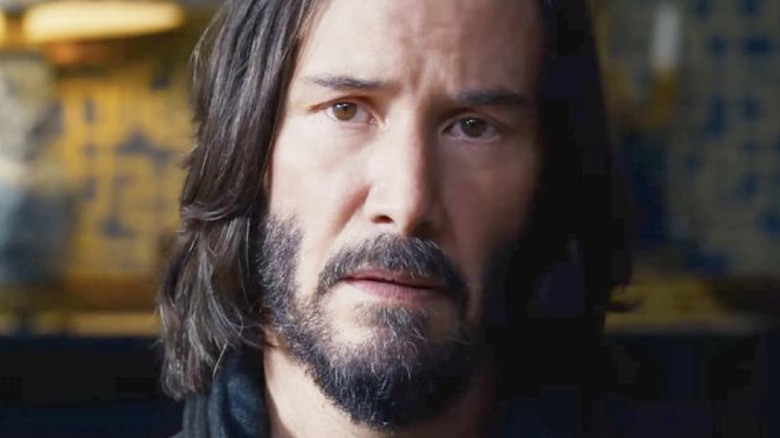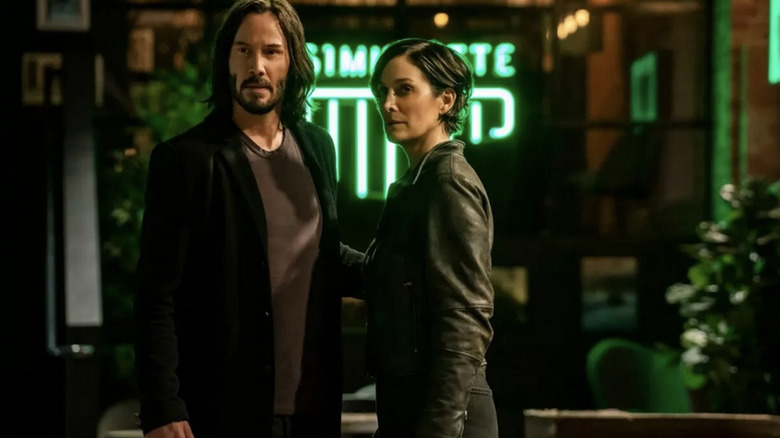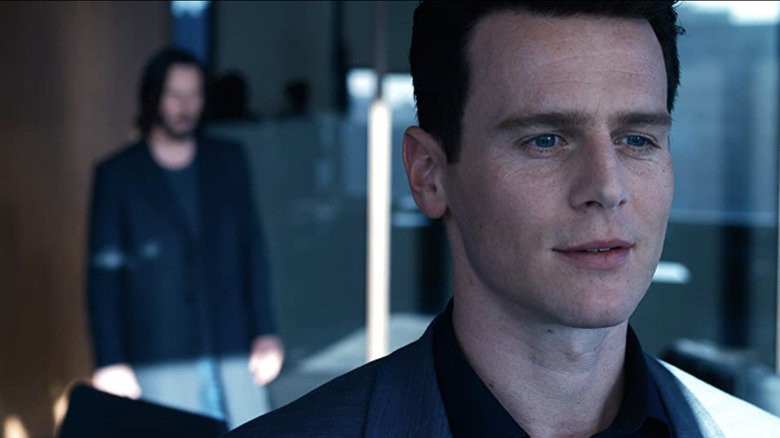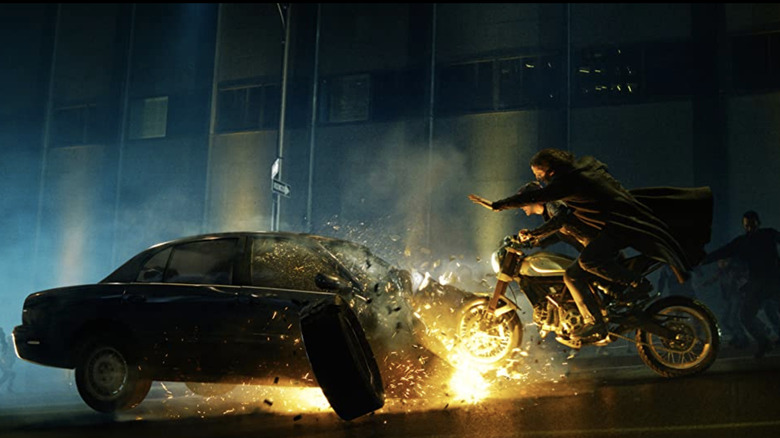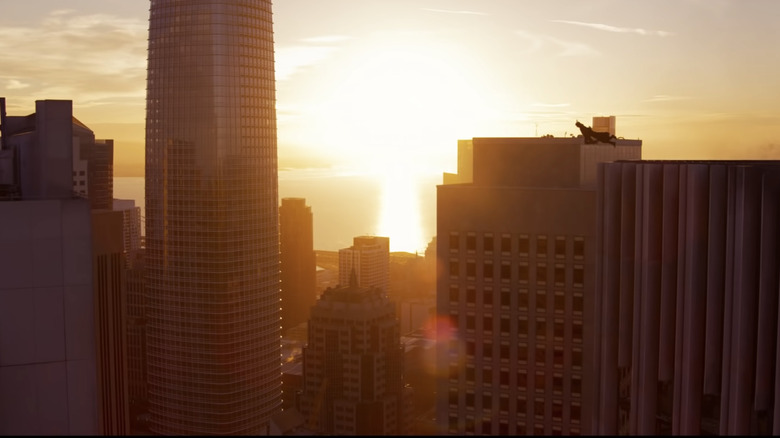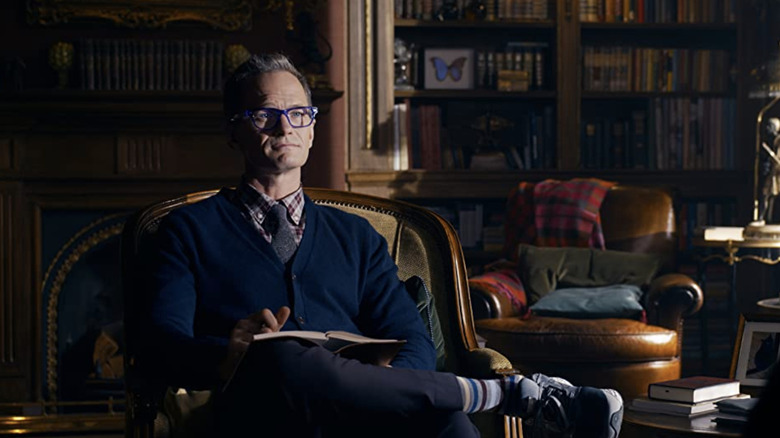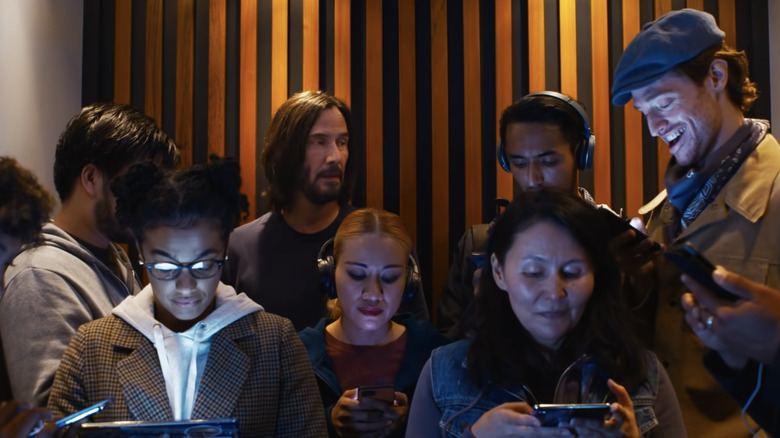The Ending Of The Matrix Resurrections Explained
It's a franchise we thought was concluded. It's a franchise beloved for mind-bending re-evaluations of reality, headache-inducing calisthenics of logic, and a nothing-is-what-it-seems aesthetic. Now the "Matrix" franchise is back — and if you're willing to take the red pill, we're gonna go there once again.
"The Matrix Resurrections" returns us to its plugged-in universe some 22 years after the original hit theaters and 18 years after "The Matrix Revolutions" last gave us a glimpse. In this film, we find our old pal Thomas Anderson a successful (if unhappy) video game designer, once again spending his days in a soulless, cubicle-filled office, consumed by the feeling that there must be more to our existence. His creepily calm therapist (Neil Patrick Harris) disagrees.
What follows is two and a half hours of revelations, revolution, and enough deja vu to make you feel like you're in the Matrix yourself. It all culminates, of course, in one of the highest-stakes endings of the year, one that could potentially launch a whole new, rebooted "Matrix" series of films.
If you've seen "Resurrections," or aren't concerned with remaining plot-pure, read on for a spoiler-heavy breakdown of the film's ending. Sit back, plug in, and wake up.
You're kidding me
For all intents and purposes, the end of "Resurrections" begins with a much-anticipated sitdown between Neo (Keanu Reeves, back in arguably his most iconic role of a career filled with iconic roles) and the Analyst (Neil Patrick Harris, oozing evil in his best villain role since 2014's "Gone Girl"). Their venue for this not-so-tete-a-tete is the delightfully named Simulatte coffee shop, where Thomas Anderson has received much of his stimulation over the years — and inspiration, via a striking woman named Tiffany who bears a striking resemblance to our old friend Trinity (Carrie-Anne Moss).
This Tiffany has much invested in the world she sees every day. She has a husband, a job, three children — but (like Neo) a persistent feeling there must be more, and a relentless affection for Ducati motorcycles. So, surrounded by enough agents to make any modern viewer uncomfortable at the sight of the not-at-all-socially-distanced coffee shop gathering, Neo and the Analyst finally lay all their cards on the table and decide to let her break the stalemate. If Tiffany decides to remain Tiffany, Neo will return to the Matrix once and for all and become Thomas Anderson again; if she decides to become Trinity, all bets are off.
"Okay," the Analyst accepts. "I like tests. We'll let Tiff decide."
Breaking down the stakes, Sati (Priyanka Chopra Jonas) adds: "The most important choice in Neo's life isn't his to make."
After watching Moss' character essentially being lobotomized for most of the film, what comes next is particularly satisfying. As her husband and kids make one last sales pitch, it appears that Tiffany might return home with them; just as Neo is being dragged away, however, she delivers four words that propel the film's ending — and perhaps, more "Matrix" movies to come.
"My name is Trinity."
Way to go, Smitty
One of the more welcomed upgrades in "The Matrix Resurrections" is the new Agent Smith. Although Hugo Weaving was nothing short of iconic in his work originating the character, he spent much of the 2010s expressing a growing distaste for blockbusters (and filming was reportedly in conflict with a play he had committed to), so it's unsurprising that the Matrix agent's visage has been changed, now to resemble "Mindhunter" breakout Jonathan Groff.
Although many moviegoers might remember Neo vs. Smith as a classic rivalry on par with Harry vs. Voldemort, Lex Luthor vs. Superman and Larry David vs. Susie Greene, over the course of the original trilogy, Smith actually gained much more nuance and complexity. His contact with Neo led him to become "unplugged," and at times he helped Neo's rebellion and even became a counterbalance of sorts, increasing his power exponentially. At the end of "Revolutions," it looked as if both Neo and Smith had been destroyed.
With "Resurrections," we once again see that Smith and Neo's fates are tied to each other. As his "boss" becomes his "enemy," Groff's Smith takes over in the key Matrix role of engaging Neo in multiple high-powered, memorable smackdowns. By the end of the film, it looks as if Smith might have been eradicated.
But when Neo and Trinity need saving, Smith once again returns from the dead, this time to fight on their side. He substantially aids their efforts in the Simulatte coffee shop. Then, vanishing once again, he points out to our heroes that "Anyone could be you. Whereas I've always been anyone."
Let the bodies hit the floor
What follows is all the butt-kicking, bullet-dodging, aerial acrobatic choreography you would expect from a "Matrix" film, this time with Neo and Trinity backed up by a new crew led by Bugs (Jessica Henwick). As the group make their way out of the Simulatte, the Analyst turns the Matrix against these viruses threatening his creation. In essence, every human in the area has the potential to be turned into a quasi-zombie, attempting to take down the heroes.
When Trinity shows up on a Ducati and has Neo hop on board, this sequence gets particularly striking — as in hundreds of bodies striking the streets down below, diving out skyscraper windows and turning themselves into bombs attempting to hit Trinity and Neo as they speed through the streets. In essence, it's the "Matrix" version of the WKRP turkey drop, but not nearly as funny.
After many close calls, explosions and imperiled colleagues, Trinity and Neo make it to their destination. But what comes next? If people are truly to be freed, the Analyst himself must be confronted. With Neo and Trinity united again, and their minds freed, anything is possible.
I believe I can fly
With that bit of business concluded and agents closing in, Neo and Trinity take to the roof of a skyscraper. Throughout the film (and really, all four films), flight is a recurring theme. Both as a metaphor (characters soaring away from the matters that would keep them earthbound) and as a weapon (honestly, can anyone look at a flying man and not find it evocative of the strongest hero in pop culture, Superman?). Going hand in hand is another recurring theme, that of birds.
Throughout "The Matrix Resurrections," Neo keeps seeing the same recurring image of birds in flight, flying in some sort of time loop. We are also told that Thomas Anderson tried to step off the roof of a building at a corporate party years ago but was pulled back at the last moment, an event witnessed by Bugs. Finally, it becomes a sort of running joke throughout "Resurrections" that people ask Neo whether he can still fly, but he can't seem to get his mojo working anymore.
All this builds to Neo and Trinity, literally taking a leap of faith. Stepping off the top of the building, holding hands, at first they begin to fall — and you'd be forgiven if you just assume Neo's old skills will kick in and he'll save the day. Instead, it's Trinity who discovers an ability to fly. Reminiscent of Neo soaring away at the end of the original "Matrix," this time it's Trinity who takes to the sky, with Neo along for the ride.
Dodge this
When the duo confront the Analyst together, the power dynamic has shifted considerably. Now, instead of dictating the terms to Neo, surrounded by dozens of his agents, he is on his heels and alone. But that doesn't stop the Analyst from bragging about his plans, waxing philosophic about the intrinsic shortcomings of mankind, and telling the duo time and again that their efforts are useless.
As if to drive home the point that he's the one fighting the losing battle, Trinity kills the Analyst — again and again, each time with him snapping back until he finally seems to admit defeat ("That was for using children," she says after one particularly nasty blow). At this point, the Analyst seems to shift from saying they'll never gain control to warning they'll come to hate the burden of having control. What are they going to do, he asks, rebuild everything with rainbows in the skies? "The sheeple aren't going anywhere," he barks.
At this point, "Resurrections" begins once again to parallel the original classic film in tone, if not in shot-by-shot reverence like we saw at the beginning. The newly reunited Trinity and Neo resolve to do exactly that, joking that the rainbow ideas sounds pretty nice. "You gave us something we thought we'd never have," says Trinity.
"What's that?" asks the Analyst.
"Another chance."
The post-credits scene
If you stick around for all the names of all the people who have to be involved in a state-of-the-art sci-fi blockbuster like this one, the first thing you'll notice is that when the title "The Matrix Resurrections" is flashed on the screen, it becomes "The Matrix Resurrects." Could this be the title of the next potential film?
Like the end of the original film, the final moments are soundtracked by the uplifting rebellion rock of "Wake Up." Only this time, rather than the ferocious Rage Against the Machine original, the cover version you hear is by a band called Brass Against, with help from Sophia Urista.
Unfortunately, the post-credits scene is a real disappointment, essentially just a joke ripped off from "Scrooged." When the titles lift and the screen lights up again, we are transported back to Thomas Anderson's old place of work, where his uninspired team (now without their leader) are still debating new marketing ideas and ways to make money off the "Matrix" franchise. They're talking about video games, of course, but as in the earlier scenes, it's all very meta.
"Face reality," someone says. "Movies are dead, games are dead. Narrative is dead."
Their solution? Create programming for felines. "What we need is a series of videos," it is proposed, "that we call 'The Cat-trix'."
Sadly, there is no rimshot after that line. Honestly, it just feels like a deleted scene ... that should have stayed deleted.
